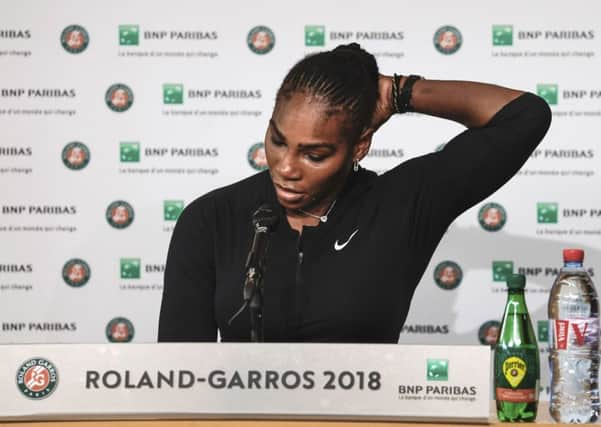Serena Williams pulls out of showdown with Maria Sharapova


Less than 20 minutes before she was due to play, Williams swept into the press conference room to tell the world that her French Open was over. She had a pectoral muscle injury, she could not serve and she was going to consult whatever specialists she could find for advice.
“I unfortunately have been having some issues with my pec muscle,” Williams explained, “and it has unfortunately been getting worse to the point where right now I can’t actually serve. It’s kind of hard to play when I can’t physically serve.
Advertisement
Hide AdAdvertisement
Hide Ad“The first time I felt it was against [Julia] Goerges in my last match. That’s when I started to feel it. It was really painful and I didn’t know what it was.
“In my doubles yesterday I tried a lot of different tapings, and I tried lots of different types of support to see how it would feel under match circumstance. It didn’t really get a lot better.
“I’m going to get an MRI tomorrow. I’m going to stay here and see some of the doctors here, see as many specialists as I can. And I won’t know [when I can train again] until I get those results.”
Williams was “beyond disappointed” to pull out. From a distinctly rusty start, she had been gathering momentum with every round, playing better and competing harder.
Her first round was average, midway through her second round she suddenly remembered how she normally wins tennis matches and by the time she got to Goerges on Saturday, she was her old, ruthless, indomitable self. The real Serena was back in business.
The prospect of playing Sharapova had clearly whetted her appetite (although not as much as it had whetted the appetite of the world’s media). She has not lost to the Russian since 2004 and holds a 19-2 winning record over her fellow megastar. When Williams says “I love playing Maria” what she actually means is she loves thrashing Maria.
The pair share a mutual animosity that positively crackles when they are drawn against each other. In her book Unstoppable, Sharapova claims that Williams hates her for thrashing her in the 2004 Wimbledon final and then overhearing Williams sobbing in the locker room afterwards.
Two days ago, when they were preparing for yesterday’s fourth round, Williams claimed Sharapova’s book was “100 per cent hearsay” and with a carefully rehearsed expression that could best be described as hurt yet magnanimous, she confessed that she bore Sharapova no ill will, none at all.
Advertisement
Hide AdAdvertisement
Hide AdBut she does not need to: when they step on court together, Williams knows there will only be one winner. Yet this meeting was going to be different.
It was supposed to be their first match in two and a half years. After their last showdown, at the Australian Open in 2016, Sharapova tested positive for meldonium and was banned for 15 months. Before she returned, Williams had gone on maternity leave – and announced her pregnancy on Sharapova’s birthday in 2017. Sharapova’s comeback is a year old; Williams’ is just starting in earnest. This would be a true test as to whether all the effort to get back on court had been worth it.
“I have given up so much to be here,” Williams said. “There are times where I’m on the court and practising, and I look on the monitor and I see my daughter and she’s playing and I want to be there, but I know these are the sacrifices you have to make to live out your dream. And I have made every sacrifice I could. So it’s extremely disappointing.
“I have been good. I have been doing so good. Every match has been getting better for me. Physically I’m doing great. It hasn’t been easy. I sacrificed so much to be at this event. I can only take solace in the fact I’m going to continue to get better.”
Whether she gets better in time for Wimbledon depends on the results of today’s scan and the advice of the doctors. A pectoral muscle strain can take between three and six weeks to heal but pectoral muscle tear can take months. Williams can only wait and see when she will be allowed back on court and when she will get another crack at Sharapova.